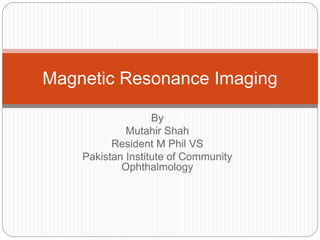
Magnetic resonance imaging
- 1. By Mutahir Shah Resident M Phil VS Pakistan Institute of Community Ophthalmology Magnetic Resonance Imaging
- 2. MRI: Magnetic resonance imaging (MRI) is a technique that uses a magnetic field and radio waves to create detailed images of the organs and tissues within your body Uses a large magnetic field to excite protons of water molecules. The energy given off as the protons reequilibrate to their normal state is detected by specialized receivers (coils) and that information is reconstructed into a computer image. Obtain Multiplanar images without loss of resolution.
- 3. Basic Sequences Weighting refers to two methods of measuring the relaxation time of excited protons after magnetic field has been switched off. T 1 and T 2 times sequences is used that is different for different tissues In practice both types of scan are usually performed The time sequence based methods are T1 weighted and T 2 weighted
- 4. T 1 Weighted. Generally optimal for viewing normal anatomy Hypointense dark colors include Cerebrospinal fluid and vitreous. Hyperintense structures include fats blood contrast agent and Melanin. Air is signal void on T 1 and T2. Calcification appears signal void fresh bleeding is signal void. We characterize the lesion on the basis of post contrast . If it take contrast it is malignant problem if does not take contrast it is benign.
- 5. T 2 weighted images Images in which water is shown as hyper intense structure. Useful for viewing pathological changes because edematous tissue (inflammation) will display a brighter signals than the normal surroundings. CSF and Vitreous become hyperintense Blood vessels appear black on T 2 unless they are occluded Pathalogies appears more on T 2 Sensitivity for calcification can’t be picked by MRI.
- 6. MR scans. (A) T1-weighted coronal image through the globe in which vitreous is hypointense (dark) and orbital fat is hyper intense (bright); (B) T2-weighted axial image in which vitreous and cerebrospinal fluid (CSF) are hyperintense; (C) T1-weighted midline sagittal image through the brain in which the CSF in the third ventricle is hypointense; (D) T2-weighted axial image through the brain in which the CSF in the lateral ventricles is hyperintense
- 7. The basic principles of MRI are listed below. T1 weighted Fat Suppression Gadolinium T2 weighted Proper ties; Useful for Intraocular structure such as optic nerve, EOM, and orbital veins. The strong fat signal within the orbit gives poor resolution of lacrimal gland and may also mask intraocular structure. T-1 weighted images with bright intraconal fat signal suppressed in the orbit allowing for better anatomic detail. Essential for all orbital MRIs. A paramagnetic agent that distributes in the extracellular space and does not cross the intact blood brain barrier .Gd is best for T 1 fat suppressed images. The lacrimal gland and EOM enhance on Gd. Suboptimal Intraocular contrast. Demylinating lesions (MS) are bright. Interpr etation Fat is Hyper intense and vitreous and Intracranial Vitreous and fat are dark. EOM are bighter after Gadolinium Most orbital masses are dark on T1 and become bright Fluid containing structures such as
- 8. Tissues/Lesions Examples. Fat Lipoma, Lipsarcoma Mucus /protienaceous material Dermoid cyst , mucocele, dacryocele, craniopharyngioma Melanin Melanoma Subacute blood (3-14 days Old) Lymphangioma with blood cyst , Hemorrhagic choroidal detachement Certain fungal infections (iron scavengers) Aspergillus Tissues/Lesions that appear Bright (Hyperintens relative to vitreous Before Gadolinium injection
- 9. Uses in Ophthalmology Excellent for defining the extent of orbital/CNS masses. Poor bone definition (fractures). Excellent for diagnosing Intracranial, cavernous sinus and orbital apex lesions, many of which affect Neuro-Ophthalmic Pathway. For Suspected neurogenic tumours (Meningioma, Glioma) Gadolinium is essential in defining lesion extent. Brain MRI in Patients suspected with Demylinating diseases.
- 10. Neuro Ophthalmic Indication The optic nerve is best visualized on coronal STIR images in conjunction with coronal and axial T1 fat saturation post-gadolinium images. Axial T1 images are useful for displaying normal anatomy. MRI can detect lesions of the intraorbital part of the optic nerve (e.g. neuritis, glioma) as well as intracranial extension of optic nerve tumours. Optic nerve sheath lesions (e.g. meningioma) are of similar signal intensity to the nerve on T1- and T2- weighted images but enhance avidly with gadolinium.
- 11. Sellar masses (e.g. pituitary tumors) are best visualized by T1-weighted contrast-enhanced studies. Coronal images optimally demonstrate the contents of the sella turcica as well as the suprasellar and parasellar regions and are usually supplemented by sagittal images. Cavernous sinus pathology is best demonstrated on coronal images; contrast may be required. Intracranial lesions of the visual pathways (e.g. inflammatory, demyelinating, neoplastic and vascular). MRI allows further characterization of these lesions as well as better anatomical localization.
- 12. Limitations of MRI Bone appears black and is not directly imaged. Recent haemorrhage is not detected, so MRI is inappropriate in patients with suspected acute intracranial bleeding. It cannot be used in patients with magnetic foreign objects (e.g. cardiac pacemakers, intraocular foreign bodies and ferromagnetic aneurysm clips). Substantial patient cooperation is required, including remaining motionless; it is poorly tolerated by claustrophobic patients as it involves lying in an enclosed space for many minutes.
- 13. Rebdomyosarcoma
- 14. Choroidal Melanoma & Detachment
- 16. Optic Nerve meningioma extending intracranial
- 17. tram-track sign is composed of two enhancing areas of tumor separated from each other by the negative defect of the optic nerve. The sign helps distinguish between optic nerve sheath meningioma and optic glioma. Optic glioma arises from glial cells within the optic nerve and there is no clear separation between the nerve and the tumor; hence the tram-track sign is not seen in optic gliomas
